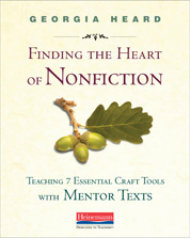Finding the Heart of Nonfiction: 7 Essential Tools with Mentor Texts
Finding the Heart of Nonfiction: Teaching 7 Essential Craft Tools with Mentor Texts
By Georgia Heard
(Heinemann, 2013 – Learn more)

Disclosure: I fell in love with this book before I even turned a page. I know this is a slight detour from the traditional book review, in which we give impressions about what we find on the inside of the text, but Georgia Heard’s Finding the Heart of Nonfiction is more than the words she wrote. The book is beautifully crafted, from the art on the cover to the “feel” of the paper used for the pages, to the understated shadows and ink drawings that paint the corner of the pages. The book’s designer – Monica Ann Crigler – gets a special nod, and thanks, from this reader.

In many ways, this attention to the relationship of art, words and message is becoming a lost art, particularly in the age of Common Core-aligned books being rushed into the marketplace. I was beginning to get the sense that every professional book and journal on my desk had come out of the same publishing machine, sort of like the “star on/star off” machine that Sylvester McMonkey McBean uses in the Dr. Seuss classic, The Sneetches.
Just as the Sneetches come to their senses and accept and celebrate their own individuality in the Dr. Seuss story, so too does Heard’s book break the mold of a typically mass-produced educational tome.
What you’ll find inside
Finding the Heart of Nonfiction centers on two central ideas that mingle with each other over the pages here. First of all, Heard argues, teachers need to bring more mentor texts into the classrooms so that young writers can see how varied and exciting good nonfiction writing can be. Heard makes the case that while the Common Core standards do in fact make a substantial shift into nonfiction text, there is plenty in that field of texts to be inspired by.
Second, Heard believes there are some fundamental elements of nonfiction craft that can and should be taught to students, so that they can become effective writers of factual prose. The seven main craft tools that Heard outlines here include:
- Focus
- Imagery
- Leads
- Point of View
- Precise Language
- Text Structures
- Endings
Chapters are sprinkled with Heard’s own stories as a reader and writer, written in a calm and welcoming voice. Finding the Heart of Nonfiction also comes with numerous “Try This” lesson ideas for each of the craft areas, so that teachers can consider mini-lessons that include more nonfiction as part of the literacy experience in their classrooms. She provides a selection of reproducible handouts for lesson plans, too.
The last chapter – titled “Nuts and Bolts: More Tools of the Nonfiction Trade” — moves away from the writing craft and into other writing and reading strategies that are connected with nonfiction, including using dialogue and quotes from primary sources, considering truth and accuracy in writing, and sentence writing. While short in length, these sections pack a lot of information for the reader and point to important topics for further exploration.
Nonfiction mentors
Finally, Heard could do a lot worse than channeling the spirit of writer Anne Lamott via Lamott’s excellent (and in my house, well-thumbed and well-read) book about writing, Bird by Bird. Like Lamott, Heard urges us to help students observe the world through mentor texts and then begin to create their own understandings through nonfiction writing that taps into creative thinking and engaging stories, transforming nonfiction in new ways.
As I write, the books behind me – my mentor texts – fill my head and heart with exquisite language and make me see the world in new ways. Writers are first and foremost readers. We read to experience the world through someone else’s heart, eyes and mind.” – Georgia Heard, page 123
Kevin Hodgson is a sixth grade teacher in Southampton, Massachusetts, and is the technology liaison with the Western Massachusetts Writing Project. Kevin blogs regularly at Kevin’s Meandering Mind and tweets more often than is healthy under his @dogtrax handle. He also blogs about the ELA classroom here at MiddleWeb.






























